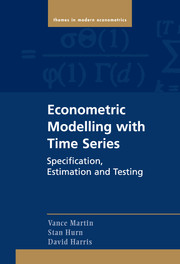Book contents
- Frontmatter
- Contents
- List of Illustrations
- Computer Code Used in the Examples
- Preface
- PART ONE Maximum Likelihood
- PART TWO Regression Models
- PART THREE Other Estimation Methods
- PART FOUR Stationary Time Series
- 13 Linear Time Series Models
- 14 Structural Vector Autoregressions
- 15 Latent Factor Models
- PART FIVE Nonstationary Time Series
- PART SIX Nonlinear Time Series
- Appendix A Change of Variable in Density Functions
- Appendix B The Lag Operator
- Appendix C FIML Estimation of a Structural Model
- Appendix D Additional Nonparametric Results
- References
- Author Index
- Subject Index
14 - Structural Vector Autoregressions
from PART FOUR - Stationary Time Series
Published online by Cambridge University Press: 05 January 2013
- Frontmatter
- Contents
- List of Illustrations
- Computer Code Used in the Examples
- Preface
- PART ONE Maximum Likelihood
- PART TWO Regression Models
- PART THREE Other Estimation Methods
- PART FOUR Stationary Time Series
- 13 Linear Time Series Models
- 14 Structural Vector Autoregressions
- 15 Latent Factor Models
- PART FIVE Nonstationary Time Series
- PART SIX Nonlinear Time Series
- Appendix A Change of Variable in Density Functions
- Appendix B The Lag Operator
- Appendix C FIML Estimation of a Structural Model
- Appendix D Additional Nonparametric Results
- References
- Author Index
- Subject Index
Summary
The vector autoregression model (VAR) discussed in Chapter 13 provides a convenient framework for modelling dynamic systems of equations. Maximum likelihood estimation of the model is performed one equation at a time using ordinary least squares, while the dynamics of the system are analysed using Granger causality, impulse response analysis and variance decompositions. Although the VAR framework is widely applied in econometrics, it requires the imposition of additional structure on the model in order to give the impulse responses and variance decompositions structural interpretations. For example, in macro econometric applications, the key focus is often on understanding the effects of a monetary shock on the economy, but this requires the ability to identify precisely what the monetary shock is. In Chapter 13, a recursive structure known as a triangular ordering is adopted to identify shocks. This is a purely statistical approach to identification that imposes a very strict and rigid structure on the dynamics of the model that may not necessarily be consistent with the true structure of the underlying processes. This approach becomes even more problematic when alternative orderings of variables are tried, since the number of combinations of orderings increases dramatically as the number of variables in the model increases.
Structural vector autoregressive (SVAR) models alleviate the problems of imposing a strict recursive structure on the model by specifying restrictions that, in general, are motivated by economic theory. Four common sets of restrictions are used to identify SVARs, namely, short-run restrictions, long-run restrictions, a combination of the two and sign restrictions. Despite the additional acronyms associated with the SVAR literature and the fact that the nature of the applications may seem different at first glance, SVARs simply represent a subset of the class of dynamic linear simultaneous equations models discussed in Part TWO.
- Type
- Chapter
- Information
- Econometric Modelling with Time SeriesSpecification, Estimation and Testing, pp. 512 - 543Publisher: Cambridge University PressPrint publication year: 2012



